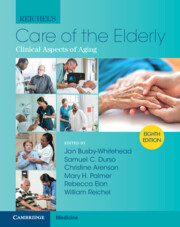Book contents
- Reichel’s Care of the Elderly
- Reichel’s Care of the Elderly
- Copyright page
- In Memoriam
- Contents
- Contributors
- Section I General Approach to the Care of the Elderly
- Section II Geriatric Syndromes
- Chapter 8 Frailty
- Chapter 9 Fall Prevention in Community-Dwelling Older Adults
- Chapter 10 Evaluation and Management of Dizziness
- Chapter 11 Evaluation and Management of Dementia
- Chapter 12 Recognition, Management, and Prevention of Delirium
- Section III Care of the Elderly by Organ System
- Section IV Principles of Care for the Elderly
- Index
- Plate Section (PDF Only)
- References
Chapter 12 - Recognition, Management, and Prevention of Delirium
from Section II - Geriatric Syndromes
Published online by Cambridge University Press: 30 June 2022
- Reichel’s Care of the Elderly
- Reichel’s Care of the Elderly
- Copyright page
- In Memoriam
- Contents
- Contributors
- Section I General Approach to the Care of the Elderly
- Section II Geriatric Syndromes
- Chapter 8 Frailty
- Chapter 9 Fall Prevention in Community-Dwelling Older Adults
- Chapter 10 Evaluation and Management of Dizziness
- Chapter 11 Evaluation and Management of Dementia
- Chapter 12 Recognition, Management, and Prevention of Delirium
- Section III Care of the Elderly by Organ System
- Section IV Principles of Care for the Elderly
- Index
- Plate Section (PDF Only)
- References
Summary
Delirium is a serious neuropsychiatric condition characterized by an acute change in cognition and attention that affects a significant proportion of hospitalized older adults and is associated with significant morbidity and mortality. Prevention of delirium is an important part of the care of hospitalized older adults. The Hospital Elder Life Program is a multicomponent intervention that has been shown to reduce the incidence of delirium. As many cases of delirium are overlooked, its diagnosis is important and can be achieved using the Confusion Assessment Method, which relies on four cardinal features of delirium: acute onset, inattention, altered level of consciousness, and disorganized thinking. The etiology of delirium is often multifactorial with contributions from predisposing factors (such as sensory impairment, chronic illness, and cognitive impairment) and precipitating factors (such as infection, polypharmacy, or illness). Once diagnosed, delirium should be evaluated with a thorough history, complete physical, medication review, and targeted tests in an effort to identify these factors. Management should focus on addressing the noted precipitating and predisposing factors with limited use of low-dose antipsychotic medications in patients at risk of self-harm.
- Type
- Chapter
- Information
- Reichel's Care of the ElderlyClinical Aspects of Aging, pp. 129 - 138Publisher: Cambridge University PressPrint publication year: 2022

